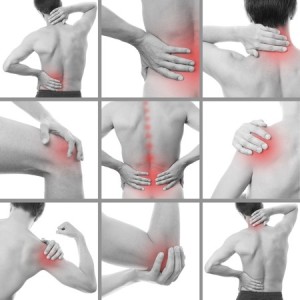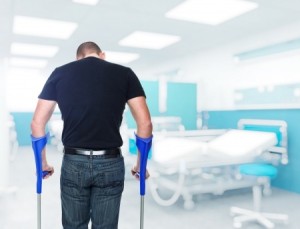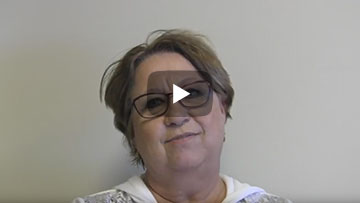
Anatomy 101
Probably everyone has seen a human skeleton or a picture of one. But did you ever think about what the skeletal system does?
The body’s skeletal system (mostly bones) provides a support structure so we can stand upright. But the bones, like a skeleton, can’t do much on their own. Add to them the muscles, ligaments and tendons of our muscular system and much of the basic anatomy necessary for human motion is now present.
Joints exist where two or more bones come together forming a connection which provides support and facilitates movement. Joints typically include bones, as well as ligaments, tendons and other structures which support the joint, act as shock absorbers and make movement possible.
Joint Injury is Common
 The joints, due to their construction, the demands placed on them and ways they must move unfortunately can easily be injured. The knee is a prime example. It is been said that the knee is one of the most complex and unstable joints in the body. Nevertheless, they are involved in every step we take. If you are a football fan you almost certainly have heard about players regularly sustaining knee injuries like a torn meniscus or damaged ACL (anterior cruciate ligament).
The joints, due to their construction, the demands placed on them and ways they must move unfortunately can easily be injured. The knee is a prime example. It is been said that the knee is one of the most complex and unstable joints in the body. Nevertheless, they are involved in every step we take. If you are a football fan you almost certainly have heard about players regularly sustaining knee injuries like a torn meniscus or damaged ACL (anterior cruciate ligament).
The forces involved in many common car accident scenarios can also cause joint injury. Although any joint can be injured in a car accident, injuries to shoulders, knees and ankles are some of the most common types of joint injuries we have seen happen as a result of car wrecks and other vehicle accidents. In joint injuries caused by car crashes the bones of the joint can be broken or tendons, ligaments, or other structures in the joint injured. Even a seemingly minor auto accident can cause trauma to a joint.
Joint and Injury Basics
Some common types of joint injuries and diseases include:
• Sprains – A joint injury that can involves the damage to joint ligaments. Overextension of the joint is a common cause.
• Dislocation – A type of joint injury that forces the end of the bone out of position, causing the bones in the joint to be misaligned.
• Torn muscles, tendons or ligaments. Examples include rotator cuff tears in the shoulder and anterior cruciate ligament injuries in the knee.
• Broken bones – In a car accident one or more of the bones which make up the joint may be fractured.
• Bursitis – Occurs when a fluid-filled sac that cushions the joint is inflamed.
• Arthritis – The inflammation of a joint. Over time, the joint may become severely damaged. Post-traumatic arthritis is a type of trauma to the joints that can occur due to a car accident.
Signs and Symptoms
Symptoms depend on the joint involved, the nature and severity of the injury. Pain is a major symptom. Swelling, stiffness, weakness and difficulty moving, inflammation, achiness and soreness are some other common symptoms. Joint injury symptoms may be variable or constant, and may either worsen or improve with movement.
Treatment Protocols and Options
Commonly, after a car accident the injured person is seen at a hospital emergency department, urgent care center or doctor’s office. The body part involved, type and severity of injury influence the type of additional medical care indicated. In cases involving serious joint injuries, for example, broken bones in the ankle, an attempt may be made in the emergency department to reduce and stabilize the fracture so the injured person can be discharged and have follow-up care on an outpatient basis. In other cases, for example, complex fractures hospitalizing the patient and prompt surgical treatment may be necessary.
When someone injured in a car wreck is seen at a emergency room or urgent care facility for injuries involving strains, sprains, torn muscles, ligaments, or tendons they are often provided medication like pain medicine and muscle relaxers. They will probably be referred to their primary care physician or a specialist like an orthopedic surgeon for follow up.
Primary care physicians may often prescribe some combination of pain medicine, anti-inflammatories and muscle relaxers. They may also recommend conservative treatment like rest, ice, compression, and elevation (also known as the RICE method), which reduces swelling, relieves pain, and speeds up the healing process. In some cases primary care physicians may order imaging studies like x-rays or MRIs to evaluate the joint injury. They may prescribe physical therapy.
Depending on the nature of the joint injury and how it is responding to treatment the primary care physician may refer a patient to an orthopedic surgeon. The orthopedist will likely examine the injured joint and may, if x-rays or MRIs have not been taken, order them. Based on this information, the orthopedic specialist, will determine whether conservative treatment like physical therapy is likely to be beneficial, or if other methods like steroid injections or surgery are indicated.
 Today, many joint injuries, for example, knee and shoulder injuries, can be treated by arthroscopic surgery. In this type of surgery, the surgeon punches one or more holes in the affected area and then inserts an instrument called an arthroscope. The arthroscope has optics which allow the surgeon to see what is going on in the joint and tools which allow the surgeon to treat the problem seen. Arthroscopic surgery is a big improvement from the type of open surgeries that were required previously because disruption to the joint and healing time are significantly reduced.
Today, many joint injuries, for example, knee and shoulder injuries, can be treated by arthroscopic surgery. In this type of surgery, the surgeon punches one or more holes in the affected area and then inserts an instrument called an arthroscope. The arthroscope has optics which allow the surgeon to see what is going on in the joint and tools which allow the surgeon to treat the problem seen. Arthroscopic surgery is a big improvement from the type of open surgeries that were required previously because disruption to the joint and healing time are significantly reduced.
For arthritis and other forms of joint injuries or diseases, surgery for joint replacement may be needed in order to remove the damaged joint and replace it with another.
Suffered a Joint Injury in a Car Accident? Contact Flick Law Firm
If you or someone you love is suffering from a joint injury or any other injury resulting from a car accident, contact Flick Law Firm. We have been successfully been helping people injured in vehicle accident cases since 1993, and we will work to get you fairly and fully compensated for your accident-related damages such as medical expenses, rehabilitation costs, lost wages, property damage, and pain and suffering.



